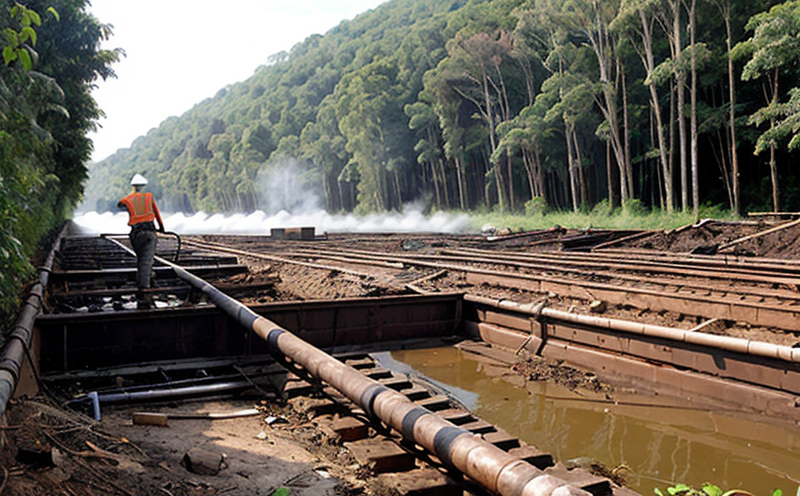EN 17036 Life Cycle Environmental Risk Management Test
The EN 17036 standard is designed to help organizations manage environmental risks throughout the entire life cycle of a product or service. This test assesses how a product's environmental impacts are managed from raw material extraction through manufacturing, use, and disposal. It aims to identify potential risks that could lead to environmental harm and provides recommendations for mitigating these risks.
The testing process involves several key steps. Initially, the lifecycle stages of the product or service are identified, including raw material procurement, production processes, distribution, end-user operations, and waste management. Each stage is evaluated for its potential environmental impact using a structured approach that includes data collection, risk assessment, and mitigation strategies.
One critical aspect of this test is the lifecycle inventory analysis (LCA), which quantifies the environmental impacts associated with each stage. This helps in identifying hotspots where improvements can be made to reduce negative environmental effects. Additionally, stakeholders such as suppliers, manufacturers, distributors, and end-users are engaged to gather comprehensive data on how their actions contribute to or mitigate these risks.
The test concludes with a detailed report that outlines the findings of the lifecycle risk assessment. This includes recommendations for improving environmental performance, which can help organizations comply with regulatory requirements and enhance their reputation among consumers who value sustainability.
For instance, companies in sectors like electronics manufacturing often use this testing to ensure they meet stringent EU regulations regarding hazardous substances (RoHS) and energy efficiency standards. In the construction industry, firms may apply EN 17036 during the design phase of a new building material or during renovations to assess the impact on local ecosystems.
Another example is in the automotive sector where manufacturers might use this test to evaluate the environmental footprint of their vehicles from cradle-to-grave. By identifying areas for improvement early in the development process, they can make informed decisions that lead to more sustainable products without compromising performance or cost.
| Stage | Main Activities | Environmental Impact |
|---|---|---|
| Raw Material Procurement | Purchasing raw materials, sourcing from suppliers | Emissions during transportation, resource depletion |
| Manufacturing Processes | Production of goods, energy consumption | Greenhouse gas emissions, water usage |
| Distribution and Transportation | Loading, unloading, shipping products | Emissions from vehicles used during transport |
| User Operations | Operating the product, user behavior | Energy consumption, waste generation |
| End-of-Life Management | Disposal of products, recycling options | Pollution from improper disposal, resource recovery |
Understanding these stages and their associated activities is crucial for effective environmental risk management. The EN 17036 test provides a structured framework to evaluate each phase comprehensively.
Why It Matters
The importance of conducting lifecycle assessments cannot be overstated, especially in today's increasingly environmentally conscious world. Regulatory bodies worldwide are imposing stricter standards and penalties for non-compliance with environmental regulations. For instance, the European Union has been proactive in introducing directives like the Restriction of Hazardous Substances (RoHS) directive which aims to reduce waste and promote recycling.
Organizations that fail to manage their environmental risks effectively risk facing legal action, reputational damage, and financial losses due to increased operational costs. Moreover, consumers are becoming more informed about the environmental impact of the products they purchase. Companies that can demonstrate a commitment to sustainability will likely see an increase in customer loyalty and market share.
From an internal perspective, managing environmental risks through lifecycle assessment ensures better resource utilization, reduces waste, and enhances operational efficiency. This not only benefits the company but also contributes positively to society and the environment. Implementing best practices early can prevent costly mistakes later on when products are already in production or on the market.
Furthermore, businesses that align their operations with environmental standards like EN 17036 demonstrate leadership within their industry. This can open up new markets and opportunities for collaboration with other environmentally responsible organizations. It also helps build trust among stakeholders including employees, customers, and investors who value corporate social responsibility (CSR).
Eurolab Advantages
At Eurolab, we pride ourselves on providing exceptional quality services that meet international standards. Our team of experts is well-versed in the nuances of EN 17036 and can guide your organization through every step of the testing process.
- Comprehensive Expertise: With years of experience, our specialists ensure accurate and reliable data collection throughout all lifecycle stages.
- State-of-the-Art Facilities: We utilize cutting-edge technology to perform precise measurements and analyses necessary for comprehensive risk assessments.
- Dedicated Consulting: Our consultants work closely with clients to interpret results and develop actionable plans based on the findings of the EN 17036 test.
Our commitment to excellence is reflected in our unwavering adherence to international standards such as ISO 9001:2015 for quality management systems. This guarantees that all tests conducted at Eurolab meet high levels of accuracy and repeatability.
We understand the complexities involved in lifecycle environmental risk management and are committed to helping organizations navigate these challenges successfully. With us, you gain access to world-class expertise tailored specifically towards your unique needs.
Use Cases and Application Examples
- Electronics Industry: A major electronics manufacturer uses EN 17036 to analyze the environmental impact of its smartphone models throughout their lifecycle. By identifying areas for improvement, they were able to significantly reduce the amount of hazardous materials used in production.
- Construction Sector: During a renovation project, a construction company employs this test to assess the potential risks associated with different types of building materials. This allowed them to choose more environmentally friendly options that meet both regulatory requirements and client expectations.
The EN 17036 standard plays an integral role in ensuring compliance with various international standards such as ISO 14001:2015 which focuses on environmental management systems. By integrating lifecycle environmental risk management into their operations, businesses can demonstrate their commitment to sustainability and contribute positively towards global environmental goals.





